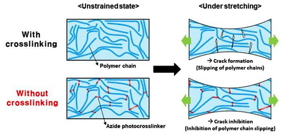Home > Press > Breaking through the limits of stretchable semiconductors with molecular brakes that harness light
 |
| Research Image
CREDIT POSTECH |
Abstract:
Like the brakes that stop cars, a molecular brake exists that can prevent semiconductor chains from slipping, enabling the creation of more groundbreaking devices. Recently, a joint research team led by Professor Kilwon Cho and PhD candidates Seung Hyun Kim and Sein Chung from the Department of Chemical Engineering at POSTECH, and Professor Boseok Kang from the Department of Nano Engineering at Sungkyunkwan University (SKKU) has developed a technology for high-performance organic polymer semiconductors that exhibit both stretchability and electrical functionality. This study was recently featured on the inside back cover of Advanced Functional Materials.
Breaking through the limits of stretchable semiconductors with molecular brakes that harness light
Pohang, South Korea | Posted on June 9th, 2023
For semiconductors to find applications in diverse flexible devices like flexible displays and skin-attachable medical devices, it is necessary to use stretchable materials instead of rigid ones. However, the force exerted during the stretching of semiconductors can be up to ten times greater than that experienced during simple bending, leading to the breakdown of the semiconductor layers and a decline in their electrical performance. Researchers have been diligently exploring methods to preserve semiconductor performance even under deformation, but a definitive solution to this challenge remains elusive.
The research team successfully created a flexible molecular photocrosslinker1 featuring azide-reactive groups at both ends. When exposed to ultraviolet light, this photocrosslinker forms a network structure with the polymer semiconductor, acting as a brake that prevents slipping even under stretching conditions. In contrast to conventional semiconductor materials, where polymer chains become intertwined and irreversibly slip and fracture when stretched, the presence of this “brake” allows the polymer chains to retain their stretchability and performance without any slipping.
Using this approach, the research team successfully preserved up to 96 percent of the electrical performance of the polymer semiconductor, even when it was stretched to 80 percent. Moreover, the semiconductor exhibited significantly enhanced stretchability and durability compared to conventional semiconductors, clearly demonstrating the effectiveness of the developed technology.
Professor Kilwon Cho explained, “By incorporating azide photocrosslinkers into the films, we have successfully preserved the excellent electrical properties of polymer semiconductors for organic thin-film transistors even under significant mechanical deformation. This simple approach significantly enhances the stretchability and UV-patternability of organic semiconducting polymers, making it highly valuable for industries requiring large-area production and photolithography for the development of next-generation flexible electronics.”
This study was conducted with the support of the Mid-career Researcher Program of the National Research Foundation of Korea and the Strategic Reinforcement of International Cooperation Network of the Ministry of Science and ICT of Korea.
####
For more information, please click here
Contacts:
Jinyoung Huh
Pohang University of Science & Technology (POSTECH)
Office: 82-54-279-2415
Copyright © Pohang University of Science & Technology (POSTECH)
If you have a comment, please Contact us.
Issuers of news releases, not 7th Wave, Inc. or Nanotechnology Now, are solely responsible for the accuracy of the content.
News and information
![]()
Single quantum bit achieves complex systems modeling June 9th, 2023
![]()
Quantum materials: Electron spin measured for the first time June 9th, 2023
![]()
Liquid metal sticks to surfaces without a binding agent June 9th, 2023
![]()
Graphene-based Carbocatalysts: Synthesis, Properties, and ApplicationsBeyond Boundaries June 9th, 2023
Flexible Electronics
![]()
Liquid metal sticks to surfaces without a binding agent June 9th, 2023
Wearable electronics
![]()
Liquid metal sticks to surfaces without a binding agent June 9th, 2023
Govt.-Legislation/Regulation/Funding/Policy
![]()
Researchers at Purdue discover superconductive images are actually 3D and disorder-driven fractals May 12th, 2023
![]()
Semiconductor lattice marries electrons and magnetic moments March 24th, 2023
Possible Futures
![]()
USTC enhances fluorescence brightness of single silicon carbide spin color centers June 9th, 2023
![]()
Single quantum bit achieves complex systems modeling June 9th, 2023
![]()
Advances in nanotechnology application in biosafety materials A crucial response to COVID-19 pandemic June 9th, 2023
![]()
Researchers discover materials exhibiting huge magnetoresistance June 9th, 2023
Chip Technology
![]()
USTC enhances fluorescence brightness of single silicon carbide spin color centers June 9th, 2023
![]()
Researchers discover materials exhibiting huge magnetoresistance June 9th, 2023
![]()
Laser direct writing of Ga2O3/liquid metal-based flexible humidity sensors May 12th, 2023
![]()
Breakthrough in the optical properties of MXenes – two-dimensional heterostructures provide new ideas May 12th, 2023
Discoveries
![]()
When all details matter — Heat transport in energy materials June 9th, 2023
![]()
Advances in nanotechnology application in biosafety materials A crucial response to COVID-19 pandemic June 9th, 2023
![]()
Researchers discover materials exhibiting huge magnetoresistance June 9th, 2023
Announcements
![]()
Liquid metal sticks to surfaces without a binding agent June 9th, 2023
![]()
Graphene-based Carbocatalysts: Synthesis, Properties, and ApplicationsBeyond Boundaries June 9th, 2023
![]()
When all details matter — Heat transport in energy materials June 9th, 2023
Interviews/Book Reviews/Essays/Reports/Podcasts/Journals/White papers/Posters
![]()
USTC enhances fluorescence brightness of single silicon carbide spin color centers June 9th, 2023
![]()
Single quantum bit achieves complex systems modeling June 9th, 2023
![]()
Advances in nanotechnology application in biosafety materials A crucial response to COVID-19 pandemic June 9th, 2023
![]()
Researchers discover materials exhibiting huge magnetoresistance June 9th, 2023










